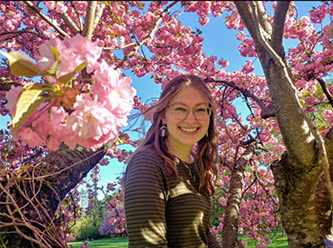Previous Cohorts
2021

Anosha Arshad
Anosha Arshad
Mentor: Daniel D. Kurylo
Project: Modeling Cortical Activity for Perceptual Grouping Formation
Video: https://www.youtube.com/watch?v=Ph8pCgVmt1M
Poster (pdf)
Abstract: Perceptual grouping allows individual components of an image to be perceptually connected. The neural process by which grouping occurs, and it’s timescale are not understood. To explore neural circuitry that mediates grouping, three hypothetical models were tested by comparing to existing data. Initially, stimulus components activate a set of neurons in the cortex (point image). As grouping progresses, point images become associated, following a neural process described by each model. Model 1 rapidly groups when lateral connections become active as point images form. Model 2 delays grouping as neural activity becomes coherent. Model 3 delays as connections project to higher cortical areas for convergence after association. Hypotheses included; (1) development across time is based on stimuli characteristics and duration of the presentation of stimuli; (2) processes must continue in activity after a brief afferent signal has been removed, leaving limited information for additional processing. Results yielded; (1) Grouping is complete at stimulus duration of 60 ms. Based on model 1, grouping is nonprogressive, facilitated by lateral connections. (2) Supported by model 2, point images are associated before 42 ms, but the process is incomplete until their oscillations are coordinated, after 42 ms. (3) Grouping is a progressive process; it proceeds to be 80% complete at a 50 ms afferent signal. Confirming model 3, point images become associated, but access higher areas to converge. So, each model is contributive to neural processes underlying grouping. Therefore, grouping is mediated through coherence of neuronal activity as well as lateral connection strength, which then leads to convergence of point images.
"My REU experience became a stepping stone in my career. Before REU I was merely intrigued by scientific research. Being in the program, I found that this was the right space for me. Not only was I able to develop my own research project, but I felt like a real scientist as we were given funding, project materials, and contributed to a scientific conference. In addition, I learned about ethics, statistics, and presentation methods in a class/discussion format. I also made connections with already established scientists and people my age. I began working in a lab long-term because of my REU connections. I know I can always come back to REU for advice. Awesome experience!"

Rebecca Elberger
Rebecca Elberger
Mentors: Faigy Mandelbaum, Dr. Jennifer Drake and Dr. Laura Rabin
Project: Undergraduate Research Students Believe That Anyone Can Be a Scientist Regardless of Race and Gender
Abstract: Stereotypes of scientists as male, Caucasian, mythical, and undesirable have deterred minority students and women from pursuing a science career1. Programs such as the NSF-funded Research Experience for Undergraduates (REU) were established to enable students to see for themselves that anyone can be a scientist. REU students participated in a semester-long laboratory research immersion and attended didactic seminars. Students’ pre-post drawings of scientists were measured using the Draw-A-Scientist (DAST) task. The study aimed to determine whether students’ drawings would depict a decrease in male representations, mythical figures, and other science stereotypes pre-post lab research training. The study also assessed whether students’ depictions would reflect an increase in REU-informed experiences. Nineteen undergraduates (M=23.37, SD=3.24) across two REU cohorts (2019-2021) impacted by Covid-19 participated. Most participants were female 79.0%. Students were 47.4% Caucasian, 15.8% Asian/Pacific Islander, 21.1% Hispanic/Latino, 10.5% African American, and 5.3% Other. Students’ pre-post drawings depicted a significant increase in REU-related experiences (i.e., poster session, laptop, science-identity themes), t(16) = 3.77, p = .002. Drawings were primarily female/gender ambiguous at both pre, 64.7% and post, 84.21%. Only 23.5% of the initial drawings and 15.8% of the post drawings depicted males. These data demonstrate that REU students are changing 32 their perceptions of who can be a scientist. This embrace of diverse science identities suggests that trends are changing for the better. (Chambers, 1983); (Miller, 2018).
"The REU was an immersive semester-long research program that enlightened me in all realms of research including how to read journals critically and ethics of research. I enjoyed the didactics as well as conversing with my fellow REU students."
Rebecca is currently studying in Long Island University's Psy.D. program.

Crystal Gilbert
Crystal Gilbert
Mentor: Yana Kuchirko
Project: Does Early School Exposure Predict Children's Use of Ethnic Labeling and Racial Identification?
Video: https://youtu.be/-kL-ekyh9Uw
Poster (pdf)
Abstract: Children develop an understanding of ethnicity & race early in life, so much so in fact, that adults unnecessarily delay conversations because they underestimate children's processing of it (Sullivan, 2021). Prior research primarily focuses on older children and adolescents, showing how youth begin to understand and integrate ethnicity/race in their own identity (French, et al., 2006). What is missing is an examination of how young children label their own ethnic/racial identity, and whether early exposure to school settings predicts children’s ability to label themselves in ethnic/racial terms. The current study poses two research questions: 1) How do young children view themselves racially?; Does this vary by child's ethnicity?; And 2) Does age of entry into preschool predict whether children will be more likely to label themselves by ethnicity/race? Mexican, Dominican, and African American reported the age at which children entered center-based care and the children were asked “What is your ethnic background?” Children's responses were recorded verbatim and analyzed for types of labels (ethnic/racial, geographical markers i.e. state or country, language). Results showed that 53% of children used socially accepted labels for ethnicity/race (e.g., Black). Chi Square test of significance showed a significant difference by ethnicity: African American children were less likely to use the socially accepted label for ethnicity and Mexican and Dominican children. Finally, analyses did not reveal significant differences in labeling by age of school entry. Findings are discussed in light of contexts that could shape children’s ethnic/racial identification.
"Anytime I think of my time in this program, I am reminded of the warm community that was built during the months we spent together. This environment was a safe space where I felt comfortable exploring my research interests and presenting my findings. I highly recommend this program to budding researchers and scholars!"
Crystal continues to conduct research as an NSF REU ILLC fellow. She works as the program coordinator for this REU program and is a research assistant at KBCC.
Daniel Mesa
Mentor: Jacob Shane
Project: Secondary Control and Depression in Adulthood: The Role of Age and Gender
Video: https://youtu.be/a0W10lTFrEs
Abstract: Research has identified how the way in which people seek to control their own development (control strategies) can be a factor in the onset of adulthood depression. For example, low capacity to change one's external environment (primary control) is linked to higher levels of depression. Less is known about the potential role that controlling one's internal thoughts and emotions (secondary control) may have. Using data from the MIDUS study (n = 3577, Mage = 57, SD = 5.76) we examined how secondary control strategies are related to depression, and whether age and gender moderated the relationship. Results showed that higher self-protection predicted lower depression, whereas higher goal adjustment predicted higher depression. Age moderated the relationship between selective secondary control and depression such that higher levels of selective secondary control predicted lower levels of depression in young adulthood but not in midlife or older age. Age also moderated the relationship between goal disengagement and depression such that higher levels of goal disengagement were predictive of higher levels of depression in young adulthood, but not in midlife or older age. Gender was not a significant moderator for any of the relationships. Findings provide both a deeper understanding of the role that secondary control strategies have in regards to adulthood depression, and the moderating role that age and gender have. These findings could be used to inform therapy in the sense that specific age groups could receive differing therapy for depression. Those in young adulthood may benefit from therapy that 31 focuses on increasing selective secondary control and reducing goal disengagement while those in midlife and older age would not reap the same benefit from that type of therapy.
"My experience with the REU project was great. It allowed me to further myself as a researcher by applying not only statistical methods, but by honing in on my understanding of research ethics. The culminating poster presentation allowed me to practice how to communicate my research findings to a broader audience."
Daniel is still heavily involved in research and is working on his honors thesis. He is currently in the process of applying to clinical psychology Ph.D. programs.
Angelina Allia
Mentor: Yu Gao
Project: The Effects of Sleep and Physical Activity on Adolescent's Internalizing and Externalizing Symptoms
Video: https://youtu.be/3nQMDuOSogw
Abstract: Adequate sleep and physical activity (PA) are both recommended to achieve a healthy lifestyle for all ages. Sleep is vital for our mood, alertness, and attention while PA enhances our mental wellbeing. Insufficient sleep has been demonstrated to negatively impact our physical health and cognitive functioning while too little PA has been shown to correlate with lower levels of satisfaction of life. The current study aimed to examine how sleep and PA levels affect adolescent’s mental health by exploring how each contributed to the display of internalizing and externalizing symptoms, risk factors for later mental health issues. Prior research has suggested that adolescents who had inadequate sleep and physical activity had the highest internalizing symptoms that include anxiety and depression. We aimed to extend these findings to externalizing symptoms that include aggression and rule-breaking behavior. The sample consisted of 116 adolescents aged 12 to 16. The Physical Activity Questionnaire for Adolescents (PAQ-A) was used to assess the overall amount of PA adolescents engaged in while the Pittsburgh Sleep Quality Index (PSQI) was used to assess their sleep duration. We expected that adolescents with inadequate physical activity and sleep duration would have the highest amount of internalizing and externalizing symptoms. Preliminary findings showed that there was no effect of sleep duration or physical activity on the level of internalizing or externalizing symptoms. Future analysis will focus on sleep quality (duration and latency) to examine whether this is a better measure of sleep in predicting internalizing and externalizing symptoms.
"The REU program was a fun and innovative experience. I enjoyed building my own research question and project and utilizing the skills learned in our didactic courses to present data. The experience bolstered my confidence in analyzing scientific data and presenting research."
Angelina is currently working as a medical scribe at RUMC and studying for the MCAT. She graduated in June 2021 and intends to apply to medical school next cycle.
Bracha E. Smith
Mentors: Faigy Mandelbaum, Jennifer E. Drake and Dr. Laura Rabin
Project: From One Student to Another: Ethics Training Seminars Impact Students' Belief That They Can Help Their Peers Navigate Ethical Dilemmas
Abstract: Undergraduate-level college programs rarely offer formal ethics training courses. Students may therefore feel uncomfortable and be ill-equipped to navigate and address ethical issues effectively. This gap in students’ training may result in undesirable support-seeking behaviors for ethical dilemmas from acquaintances who are unfamiliar with research protocols rather than from competent mentors. This study provided 9 cohorts (n=97) of NSF-funded Research Experience for Undergraduates (REU) students with research-focused ethics didactics and assessed students’ changing ethics-related perceptions. Demographically diverse participants included: 45.5% Caucasian/White, 19.6% Asian/Pacific Islander, 19.6% African American/Black, 14.4% Hispanic/Latino, and 1% Other, ages 20 to 45 (M=25.1, SD=5.8), of which 75.3% were female. The ethics training included CITI training and 10 ethics modules. Posttraining, a majority of students shared that they would be comfortable advising a friend on how to respond to ethical dilemmas in research settings; Agree (60.9%), Somewhat agree (18.4%), Neither agree nor disagree (14.9%), Somewhat disagree (1.1%), Disagree (2.3%). Additionally, a paired samples t-test highlights students’ increased perceptions on the importance of confidentiality in their research practice, t(86) = 2.99, p=.004; and the importance of justice in their research practice, t(85) = 4.34, p.
Melissa Ceren
Mentor: Jennifer Drake
Project: Viewing Art Virtually: Benefits of Aesthetic Experience on Mood Improvement and Emotion Regulation
Abstract: During the COVID-19 pandemic, individuals were found to use the arts as a form of distraction and escape (Drake et al.,in preparation). Research has shown that drawing improves mood in adults when used as a form of distraction rather than expression (Drake & Winner, 2012). Do the benefits of engaging in the arts also extend to viewing art? This study investigated the aesthetic and mood experience of viewing art when participants were asked to focus on the visual properties of works vs. their emotional experience when viewing the works. Participants were 60 mTurk users who were randomly assigned to one of the three conditions: Visual Properties, Introspection, or a Control. Each condition viewed 8 paintings (4 positive and 4 negative). In the Visual Properties condition, participants were asked to identify the elements of each painting’s line, shapes, colors, and light. In the Introspection condition, participants were asked to reflect on their own emotions when viewing each painting. In the Control condition, participants passively viewed each painting. All conditions rated how each painting “moved” them. After viewing the images, all conditions reported their mood improvement and use of emotional regulation strategies. We found that being moved was positively correlated with participants' experience of positive and negative emotions, suggesting that participants experienced mixed emotions while viewing paintings. Across conditions, there were no differences in being moved, positive affect, or negative affect. Additionally, participants were more likely to use the viewing experience as an approach to emotion regulation strategy than a self-development strategy. Further studies should investigate art viewing under these specific conditions in a museum or laboratory settings.






